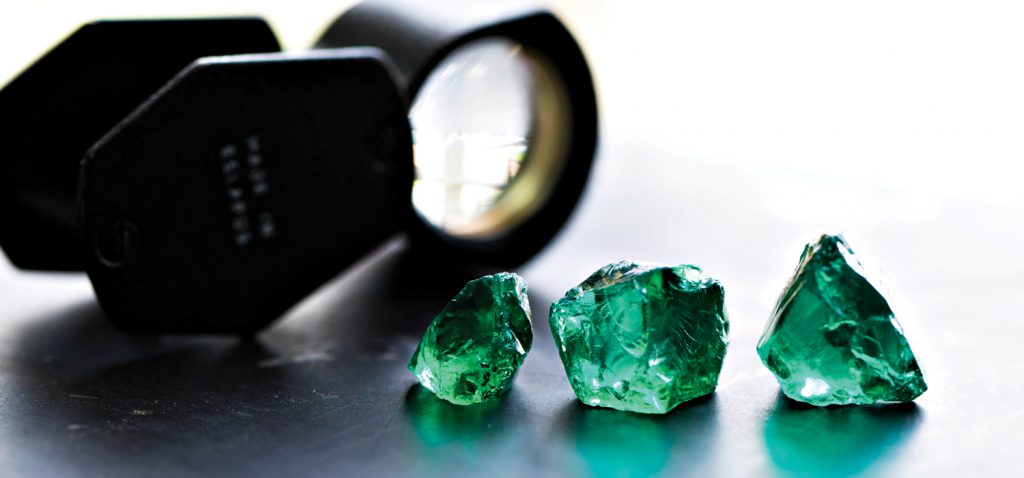SA Mining
In Demand: Gorgeous Gems Stones
By: Nelendhre Moodley
JSE-listed coloured gemstone miner Gemfields’ Kagem emerald mine in Zambia, which produces around 25% of the world’s emerald supply, has over the past decade tripled its gemstone production.
How has the gemstone market grown over the past two to five years?
Demand has grown markedly. A decade ago colourless diamonds were widely perceived by consumers to be the most prestigious of gems. Today the swing towards precious coloured gemstones is overwhelming.
The past four years have seen world record prices for an emerald and a ruby surpass that of a colourless diamond on a per-carat basis, with the current records set at auctions held by Christie’s.
It surely can’t be long before sapphires (a record presently held by Sotheby’s) surpass colourless diamonds too.
When combined with significant improvements in the supply chain, particularly in respect of reliable and responsible sources of supply, it is no surprise that we’ve seen such growth in the sector.
The recent discovery of rubies in Mozambique in 2009 has been a real game changer. Mozambique has fast become the world’s number one ruby exporter, yielding record-breaking auction results for Gemfields.
Following US-led bans in 2008 on rubies from Burma, Mozambique’s consistency and transparency of supply have instilled renewed confidence in rubies and have enabled high-end jewellery brands to create extraordinary capsule collections with fine rubies they would typically have spent years collecting.
Interestingly, people often forget that the well-known laws of supply and demand apply to “efficient markets”, a term that cannot yet be used for the coloured gemstone sector. Gemfields’ Kagem emerald mine in Zambia is a case in point: today it produces an estimated 25% of world emerald supply. Over the past decade its gemstone production has tripled while the prices received have increased more than sixfold.
What are the key drivers for this growth and the trends influencing it?
From young royals to high-profile actresses, coloured gemstones have basked increasingly in the limelight in recent years.
Not only are fine rubies and emeralds rarer than colourless diamonds, but they provide a highly appealing colour contrast to those who already have colourless diamonds.
It helps of course when the world’s leading auction houses have seen a significant increase in both the interest in, and value of, precious coloured gemstones, with world records occurring on multiple occasions during the past decade.
And then of course there are the luxury sector’s millennials, who rightly attach far greater importance to understanding the origin of their purchases, the conditions under which they were produced and therefore whether their purchases will benefit or exploit those at the other end of the supply chain. Gemfields’ core values of transparency, integrity and legitimacy speak directly to these concerns.
The increases in demand have stemmed in large measure from improving consumer confidence given unparalleled insight into how Gemfields’ gems are mined and our ability to provide a reliable and regular supply of responsibly sourced gemstones.
The industry is rightly undergoing heightened supply chain scrutiny with consumers increasingly asking for certificates of origin, requiring much improved knowledge and documentation at the retail level.
In conjunction with the Gübelin laboratory in Switzerland, we launched the use of nanoparticles in our higher-quality emeralds, allowing – for the first time – their mine of origin to be determined for decades to come via Gübelin’s Provenance Proof programme.
At Gemfields we aim to operate in a manner that contributes positively to national economies of our host countries and to build lasting, sustainable livelihoods for the communities around our mines. We are proud of our leadership position in this field and we continually work to improve the awareness and delivery of sustainability within our industry all the way through to the end consumer.
What are some of the challenges faced by the gemstone industry?
The gemstone industry is ancient and complex, and there’s no shortage of challenges to negotiate.
We see promising signs of recovery in India: the Indian market is particularly important when it comes to the sale of commercial-quality emeralds and has been navigating challenging financial conditions for some time. It now appears to have turned a corner and we hope it will continue to go from strength to strength.
The biggest impediment for our emerald mine Kagem remains the new 15% Zambian export duty, imposed on emeralds since 1 January 2019. When combined with the pre-existing 6% mineral royalty tax, Zambian emerald exporters must now pay an effective 21% turnover tax on their revenues, which hands the tactical advantage to other emerald-producing countries like Brazil and Colombia, neither of which have any export duty on emeralds. We continue to liaise with the key government departments in seeking a resolution and remain hopeful that a solution will be found.
How are elements associated with climate change affecting gemstone mining?
We are realistic and open about the impact of a mining operation on the environment, but strive to minimise impact wherever possible. We carry out environmental studies to guide us in managing our sites in a way that not only meets, but where possible exceeds, national and international requirements. We aim to be operating to ISO14001 to help the continuous improvement process.
Before we mine an area, we collect seeds of the indigenous plants and trees from the top soil and create a seed bank. We then grow the seeds in a nursery for replanting as we complete mining. We do this on an ongoing basis to minimise the impact on the land and encourage biodiversity. Our practices do not use chemical substances that are hazardous to health or polluting. Machine oil is carefully discharged; machines and vehicles are maintained by our in-house teams.
What is Gemfields’ contribution to the industry?
Globally accepted principles and standards in the coloured gemstone sector are yet to be developed and Gemfields is setting new benchmarks for environmental, social and safety practices. Taking a leadership role, we are working to support increased transparency across the wider downstream supply chain, providing discerning customers with increased confidence in the responsible journey their gemstones have taken all the way from our mines.
Sustainability or responsible sourcing is therefore a key part of this.
Responsible sourcing for Gemfields means operating in a way that contributes positively to national economies, takes a leading role in modernising the coloured gemstone sector and builds lasting, sustainable livelihoods for the communities around our mines.
We believe that coloured gemstones should be mined and marketed by championing three key values – legitimacy, transparency and integrity.
Legitimacy: We go over and above accepted practices operating in a way that not only meets international and national laws, but that also challenges the sector by setting new benchmarks around sustainability.
Transparency: To lead we must be transparent. As well as leading with our own standards and initiatives through our downstream supply chain, we are working with partners to standardise strong, transparent practices across the industry.
Integrity: We are committed to embedding tangible operational actions from the mines onwards, to support sales and marketing of our product. Our proprietary grading system provides our partners with trusted evaluation and declaration of treatment.
What are some of the latest developments underway at Gemfields from a business and operational point of view?
This year Gemfields introduced the most technologically advanced coloured gemstone sort house in the world at its operations in Mozambique, with state-of-the-art equipment, like optical sorting machines. In addition, a proprietary grading system, pioneering auction platform and an active marketing presence means Gemfields plays a significant role in the rise of African gemstones. This endeavour is coupled with a strong belief that coloured gemstones should create a positive impact for the country and community from which they originate.







 Sign-up and receive the Business Media MAGS newsletter OR SA Mining newsletter straight to your inbox.
Sign-up and receive the Business Media MAGS newsletter OR SA Mining newsletter straight to your inbox.